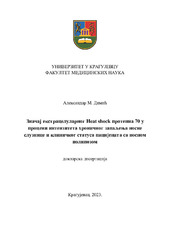Приказ основних података о дисертацији
Značaj ekstracelularnog Heat shock proteina 70 u proceni inteziteta hroničnog zapaljenja nosne sluznice i kliničkog statusa pacijenata sa nosnom polipozom
Significance of extracellular Heat shock protein 70 in assesing the intensity of chronic inflammation of the nasal mucosa and the clinical status of patient with nasal polyposis
| dc.contributor.advisor | Perić, Aleksandar | |
| dc.contributor.other | Mihaljević, Olgica | |
| dc.contributor.other | Stojanović, Jasmina | |
| dc.contributor.other | Baletić, Nenad | |
| dc.creator | Dimić, Aleksandar | |
| dc.date.accessioned | 2024-04-03T19:52:48Z | |
| dc.date.available | 2024-04-03T19:52:48Z | |
| dc.date.issued | 2023 | |
| dc.identifier.uri | http://eteze.kg.ac.rs/application/showtheses?thesesId=8710 | |
| dc.identifier.uri | https://fedorakg.kg.ac.rs/fedora/get/o:1669/bdef:Content/download | |
| dc.identifier.uri | https://nardus.mpn.gov.rs/handle/123456789/22406 | |
| dc.description.abstract | Ciljevi Nivoi biomarkera u nosnom sekretu mogu da odražavaju inflamatorni status nosne sluzokože i evoluciju bolesti sinusa. Cilj ovog istraživanja bio je da se proceni odnos između proizvodnje lokalnih inflamatornih medijatora i kliničkih karakteristika pacijenata sa nazalnom polipozom (NP). Metode U ovu studiju preseka uključen je 31 pacijent sa NP koji nisu bili senzibilisani na aeroalergene (NANP), 29 pacijenata sa NP koji su bili senzibilisani na aeroalergene (ANP) i 30 ispitanika bez zapaljenja nosne sluznice kao kontrolna grupa ispitanika (C). Procenjivani su klinički parametri (simptomi, endoskopski i radiološki nalaz). Koncentracije proteina toplotnog šoka 70 (HSP70), eozinofilnog katjonskog proteina (ECP), triptaze, supstance P i Klara ćelijskog proteina 16 (CC16) merene su u uzorcima nazalnog sekreta svih učesnika ELISA metodom. Rezultati Naši rezultati su pokazali veće koncentracije HSP70, ECP i triptaze kod pacijenata sa ANP nego kod pacijenata sa NANP, kao i u kontrolnoj grupi ispitanika (S) (p < 0,001 za sve markere). S druge strane, nivo CC16 je bio značajno viši u grupi C nego kod pacijenata iz grupa NANP i ANP (p < 0,001; p < 0,001, prema redosledu). Pronašli smo pozitivne korelacije između koncentracija HSP70, ECP, triptaze i supstance P u nosnom sekretu i intenziteta simptoma (ukupnog skora simptoma) kod pacijenata sa NP. Takođe, HSP70, ECP, triptaza i supstanca P su pokazali različite nivoe pozitivne korelacije među sobom, pri čemu je HSP70 pokazao najveću pozitivnu korelaciju sa ECP. Konačno, pronađene su relativno visoke vrednosti negativne korelacije između nivoa CC16 i nazalnih simptoma, kao i između nivoa CC16 i nivoa ostala četiri medijatora u nosnom sekretu. Zaključak HSP70, ECP, triptaza i supstanca P mogu igrati ulogu u patogenezi NP. Rezultati sugerišu da hronična inflamacija u NP uključuje samoodrživo lokalno oslobađanje HSP70, ECP i triptaze, nezavisno od aeroalergenske stimulacije mukoznog sloja, iako je proizvodnja ovih medijatora veća kod pacijenata sa NP senzibilisanim na aeroalergene. | sr |
| dc.description.abstract | Objectives Biomarker levels in nasal secretions can reflect the inflammatory status of nasal mucosa and evolution of sinus disease. The aim of this study was to evaluate the relationship between local inflammatory mediator production and clinical characteristics of patients with nasal polyposis (NP). Methods Thirty-one nonaeroallergen sensitized patients with NP (NANP), 29 aeroallergen sensitized patients with NP (ANP), and 30 subjects without inflammation of nasal mucosa as controls (C) entered this prospective, cross-sectional study. Clinical parameters (symptoms, endoscopic, and radiological findings) were assessed. The concentrations of heat shock protein 70 (HSP70), eosinophil cationic protein (ECP), tryptase, substance P and Clara cell protein 16 (CC16) were measured in the nasal secretion samples of all participants by ELISA method. Results Our results showed higher concentrations of HSP70, ECP, and tryptase in ANP than in NANP and C (p < 0.001 for all markers). On the other hand, levels of CC16 were significantly higher in C than in NANP and ANP groups (p < 0.001; p < 0.001, respectively). We found positive correlations between HSP70, ECP, tryptase, and substance P levels and nasal symptom score in patients with NP. Also, HSP70, ECP, tryptase, and substance P showed different levels of positive correlation among themselves, with HSP70 showing highest positive correlation with ECP. Finally, relatively strong negative correlations were found between the levels of CC16 and nasal symptoms, as well as between the CC16 levels and levels of other four mediators in nasal fluid. Conclusion HSP70, ECP, tryptase, and substance P might play a role in the pathogenesis of NP. The results suggest that chronic inflammation in NP involves a self-sustaining local release of HSP70, ECP, and tryptase, independent of aeroallergen stimulation of the mucosal layer, although the production of these mediators is higher in aeroallergen sensitized NP patients. | en |
| dc.format | application/pdf | |
| dc.language | sr | |
| dc.publisher | Универзитет у Крагујевцу, Факултет медицинских наука | sr |
| dc.rights | openAccess | en |
| dc.rights.uri | https://creativecommons.org/licenses/by/4.0/ | |
| dc.source | Универзитет у Крагујевцу | sr |
| dc.subject | nosna polipoza, protein toplotnog šoka 70, eozinofilni katjonski protein, triptaza, supstanca P, Klara ćelijski protein 16, endoskopski skor, LundMackay skor | sr |
| dc.subject | nasal polyposis, heat shock protein 70, eosinophil cationic protein, tryptase, substance P, Clara cell protein 16, Endoscopic score, Lund-Mackay score | en |
| dc.title | Značaj ekstracelularnog Heat shock proteina 70 u proceni inteziteta hroničnog zapaljenja nosne sluznice i kliničkog statusa pacijenata sa nosnom polipozom | sr |
| dc.title.alternative | Significance of extracellular Heat shock protein 70 in assesing the intensity of chronic inflammation of the nasal mucosa and the clinical status of patient with nasal polyposis | en |
| dc.type | doctoralThesis | |
| dc.rights.license | BY | |
| dc.identifier.fulltext | http://nardus.mpn.gov.rs/bitstream/id/160636/Doctoral_thesis_15419.pdf | |
| dc.identifier.rcub | https://hdl.handle.net/21.15107/rcub_nardus_22406 |


